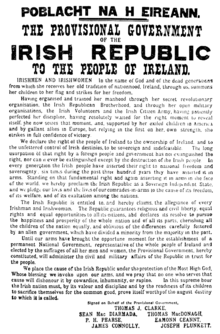1916 Easter Rising
| Easter Rising Éirí Amach na Cásca |
|||||||
|---|---|---|---|---|---|---|---|
 Proclamation of the Republic, Easter 1916 |
|||||||
|
|||||||
| Belligerents | |||||||
|
Irish Volunteers Irish Citizen Army Cumann na mBan Fianna Eireann Some members of Hibernian Rifles |
British Army Royal Irish Constabulary |
||||||
| Commanders and leaders | |||||||
|
Patrick Pearse James Connolly Tom Clarke Seán MacDermott Joseph Plunkett Éamonn Ceannt Thomas MacDonagh |
Lord Wimborne Augustine Birrell Matthew Nathan Lord French Lovick Friend John Maxwell William Lowe |
||||||
| Strength | |||||||
| 1,250 in Dublin, ~2,000–3,000 volunteers elsewhere, but they took little part in the fighting. |
16,000 British troops and 1,000 armed RIC in Dublin by the end of the week. | ||||||
| Casualties and losses | |||||||
| 66 killed 16 executed unknown wounded |
143 killed 397 wounded |
||||||
| 260 civilians killed 2,217 civilians wounded Total killed: 485 |
|||||||
The Easter Rising (Irish: Éirí Amach na Cásca), also known as the Easter Rebellion, was an armed insurrection in Ireland during Easter Week, April 1916. The Rising was launched by Irish republicans to end British rule in Ireland and establish an independent Irish Republic while the United Kingdom was heavily engaged in the First World War. It was the most significant uprising in Ireland since the rebellion of 1798, and the first armed action of the Irish revolutionary period.
Organised by a seven-man Military Council of the Irish Republican Brotherhood, the Rising began on Easter Monday, 24 April 1916, and lasted for six days. Members of the Irish Volunteers—led by schoolmaster and Irish language activist Patrick Pearse, joined by the smaller Irish Citizen Army of James Connolly and 200 women of Cumann na mBan—seized key locations in Dublin and proclaimed an Irish Republic. The British Army brought in thousands of reinforcements as well as artillery and a gunboat. There was fierce street fighting on the routes into the city centre, where the rebels put up stiff resistance, slowing the British advance and inflicting heavy casualties. Elsewhere in Dublin, the fighting mainly consisted of sniping and long-range gun battles. The main rebel positions were gradually surrounded and bombarded with artillery. There were isolated actions in other parts of Ireland, with attacks on the Royal Irish Constabulary barracks at Ashbourne, County Meath, County Cork and in County Galway, and the seizure of the town of Enniscorthy, County Wexford. Germany had sent a shipment of arms to the rebels, but the British had intercepted it just before the Rising began. Volunteer leader Eoin MacNeill had then issued a countermand in a bid to halt the Rising, which greatly reduced the number of rebels who mobilised.
...
Wikipedia
